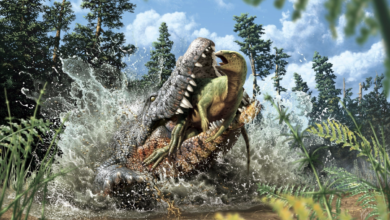Scientists discover distant cousin of T-rex in museum in plain sight

The distant cousin of theTyrannosaurus rex was discovered hiding in plain sight after being displayed inside a museum for years.
The creature, known as Tyrannosaurus mcraeensis, was mistakenly displayed as a T rex inside a museum in Albuquerque, New Mexico, before scientists reassessed the fossils.
It is thought to have come from southern America and migrated to what is now Montana, Wyoming and Canada around 67m years ago.
Here, the Tyrannosaurus developed to its terrifying 40 foot size, or the equivalent of a double decker bus, according to University of Bath researchers.
The dinosaur was previously assumed to have evolved in parts of Asia and migrated to North America over millions of years.
“The differences are subtle, but that’s typically the case in closely related species,” Dr Nick Longrich, a co-author from the Milner Centre for Evolution at the University of Bath, told MailOnline.
“Evolution slowly causes mutations to build up over millions of years, causing species to look subtly different over time,” he added.
The findings are based on a partial skull collected years ago from western New Mexico and on display at the New Mexico Museum of Natural History and Science (NMMNHS).
Based on the location of other fossil finds that have previously been dated to between 66 and 75 million years ago, the researchers suggest T mcraeensis may have lived between 71 and 73 million years ago – some five to seven million years before T rex.
Last year, palaeontologists discovered two new species of dinosaur, with one set of fossil fragments coming from a creature thought to be one of the largest to ever exist.
Uncovered in Argentina’s southern Patagonia region, the gigantic species of long-necked herbivorous dinosaur would have weighed 50 tonnes and measured 30 metres in length – roughly equivalent to that of a blue whale.
Its bones were so big that they caused a van carrying them to a laboratory to tip over, with scientists naming the dinosaur ‘Chucarosaurus Diripienda’, meaning scrambled, after its remains were rolled around during the car accident.
The dinosaur lived during the Late Cretaceous period, between 100.5 million and 66 million years ago. A study published in May 2023 described the dinosaur as having “relatively slender fore and hindlimbs” despite its gigantic size.
Based on the location of other fossil finds that have previously been dated to between 66 and 75 million years ago, the researchers suggest T mcraeensis may have lived between 71 and 73 million years ago





